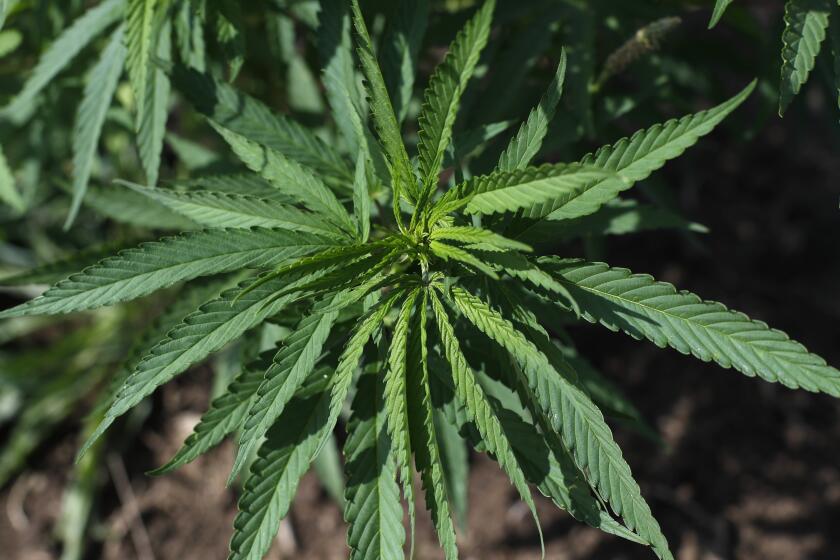Angeles Forest Pot Plantation Poses Big Risk for Authorities : Drugs: Agents spend a week chopping down 6,000 plants on 25 acres in rugged countryside.
The chopper bobs and weaves up the canyon, fighting hot, humid gusts of wind.
In the dense foliage below, drug agents with machetes, assault rifles and battle fatigues hack thousands of marijuana plants spread over 25 acres. The crop is camouflaged against the rugged mountainside, in terraced rows on the shadowy north slopes.
Before authorities arrived, the growers had been working among the trees for months, creating an elaborate irrigation system and a full camp, with tents, propane stoves and a vegetable garden.
But this was not some remote outpost in Colombia or Mexico or Humboldt County. This plantation sat 20 miles from downtown Los Angeles, in the San Gabriel Mountains.
Last week, U.S. Forest Service agents, working with the Sheriff’s Department and Monrovia police, removed 6,000 marijuana plants from a network of six “gardens” just off Angeles Forest Highway between La Canada Flintridge and Palmdale. It was the biggest marijuana plantation discovered in the area in several years.
The seizure--although significant--is but a small patch of the illegal pot fields growing in local mountains as predominantly Mexican drug traffickers have found it easier to grow marijuana in Angeles National Forest and other public lands than smuggle it across the border, authorities said.
Only nine federal officers and two investigators patrol 1 million acres of Los Angeles County’s mountains, dealing with crimes ranging from dumped bodies to motorcycle racing to gang fights.
Battling marijuana cultivation, and the significant environmental degradation it causes, takes up most of their time. On this front of the war on drugs, agents say, they are losing ground.
“The Angeles National Forest covers one-quarter of L.A. County,” said Special Agent Mike Alt. “And you have nine patrol officers and two agents.”
The budget for the U.S. Forest Service officers is meager and shrinking. About $340,000 is allocated this year for drug enforcement in the forests of Southern California, said Tommy LaNier, special agent in charge of law enforcement for the forest service.
In the meantime, authorities have been finding more gardens with thousands of plants each, and growers are increasingly armed with a lot more than Miracle Gro.
Often, authorities seize automatic weapons and deadly booby traps--such as guns rigged to shoot at intruders--used to fend off law enforcement and pirates out to steal their goods. However, officials say that hiking well-trodden trails is safe.
Forestry agents estimate they find about a third of what is grown in the forest, based on the remains of crops they find after the fall harvest.
About 10,000 to 15,000 marijuana plants are removed from the forest every year, which is comparable to the other national forests in Southern California. A massive 23,000-plant garden was eradicated from the San Bernardino forest last week and a 10,000-plant crop was discovered near Santa Barbara this month.
Last week’s discovery of the high quality sinsemilla plants--about five feet tall--could have yielded between one and three pounds of smokable “bud,” said Rita Wears, special agent with the U.S. Forest Service.
At about $2,000 per pound, that’s between $12 million and $36 million of marijuana.
Taking marijuana off the street is not the only reason officials want the farms eliminated.
A key concern is water. Angeles National Forest was established last century to protect the watershed around Los Angeles, and marijuana cultivation puts pesticides and fertilizers directly into streams and rivers. “Our principle objective out here is to stop the resource damage,” said Wears. “I have never seen a garden that covered an area this large.” Nor had she seen such damage to the environment.
Massive piles of cleared chaparral clogged streams, litter was strewn about, and pesticides poisoned the water courses. Moreover, most of the growers’ trash had been burned, posing an extreme fire danger in the tinder-dry brush.
Two men were arrested on the highway walking to the farm last week, but were released because authorities did not gather enough evidence against them in time to press federal charges. As is common, one was an illegal immigrant who allegedly was hired off the street as a day laborer and offered high wages to tend the plants.
“I caught a guy who said he made $500 a week,” Alt said. “I asked him if it was worth it. He said, ‘You know how much that is in Mexico?’ ”
Agents rarely bust anyone higher than low-level workers. They say most of the marijuana in Angeles National Forest is grown by major Mexican drug traffickers who cultivate public land in California rather than risk crossing the border with bales of pot or having their property here seized under asset forfeiture laws.
Though much of the marijuana sold in Southern California still comes from south of the border, the high quality hybrids are often home-grown, with five times the narcotic ingredient THC, and designer names such as Blueberry, Bubble Gum and AK 47, according to the state Bureau of Narcotics Enforcement.
Alt first spotted the garden from a sheriff’s helicopter Aug. 16. Flying in the mountains is dangerous, and spotting the brilliant green marijuana leaves among the dry brush is surprisingly difficult. The plants can grow below the canopy.
In the past few years, the growers have begun cultivating mid-slope instead of in the stream beds, giving them a better view of approaching law enforcement.
Finding a clandestine farm is just the beginning of the work. Tearing it out and hauling the plants away is both arduous and dangerous.
Last week, it took three days to clear the garden with a team that included all of the forestry officers, a sheriff’s helicopter pilot, several deputies and Monrovia police.
“Because we were doing this all week, we had nobody on patrol,’ Wears said.
Because there was no trail and the brush was so impenetrable and steep, the officers were dropped in by helicopter, carrying rifles in case any growers returned.
For three days, they tied bales of the wilting plants to a net and cable dangling from the helicopter. The pilot transported each load to the command center on the highway where it was loaded onto a flatbed truck. On Thursday afternoon, the wind became so erratic that it sent a load of pot dangerously gyrating beneath the helicopter, making it impossible for the pilot to land on his target.
“It’s like the load of dope from hell,” Wears radioed to pilot Larry Steward. “Just get rid of it.”
Steward struggled in the gusty mountain air for almost 10 minutes before dropping the load farther down the highway. The pot bounced and rolled down a ravine, where authorities spent a good part of the afternoon trying to recover it.
When Steward returned after his white-knuckled flight, one of the officers jokingly pointed to the truck and offered: “We ought to roll some of that stuff up for you.”
More to Read
Sign up for Essential California
The most important California stories and recommendations in your inbox every morning.
You may occasionally receive promotional content from the Los Angeles Times.











